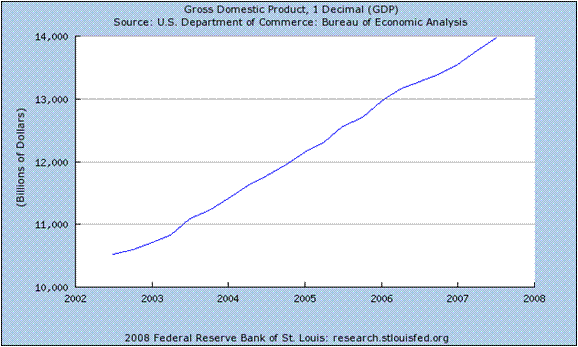What the Markets Want
In every economy around the globe, capital is fleeing the risk of productive investment and seeking shelter to preserve its value. As major equity indices drop high-single-digit percentages in a single day, repeatedly, U. S. Treasury securities rise in price as the government’s cost of borrowing actually declines. This is what occurs when the private economy fears the effects of public policies.
Increasingly since mid-2007, the U. S economy and financial markets have been discounting the prospects for extension of the existing marginal rates of income tax enacted in May, 2003. That is to say, those marginal rates are being seen as less and less likely to be extended past the dates set by law for their termination in 2010.
Retracement of 2003-2007 GDP Growth?
Those lower rates are also seen, correctly, as the prime mover in the economic recovery by the U. S. and the world after the financial crash of 2000-2002, and the Twin Towers attack of September 11, 2001. Take away those lower tax rates and the U. S. economy is unlikely to produce more jobs or output than was the case before the tax rates were adopted. Here is a graph of GDP growth since the 2003 tax cuts.

The markets do not relish the prospect of U. S. GDP retracing to its 2003 level, with all its implications for other global economies. Yet, as 2008 begins, the political outlook provides little reason to believe existing tax rates will be extended beyond 2010. Thus, the markets see major tax increases looming in the future, and the commensurate contraction in GDP.
Paulson “Czarship” Disappoints
No short term “fiscal stimulus package” of the nature being discussed by Congress and the White House will resolve this concern, because the relevant facts on the ground will remain essentially the same. A permanent cut in the corporate income tax rate would be beneficial in itself, but that would be a poor bargain for returning to higher rates on capital gains and dividends. Tax rebates and longer unemployment benefits relieve distress and reduce inventories in minimal ways, but do little to induce new investment or increased production. For one heralded as the coming economic “czar” when he came to Treasury from Wall Street, Secretary Paulson has displayed very little hardheaded leadership on such important issues.
Another Paulson shortcoming is complete destruction of Treasury credibility on dollar policy. He has repeated the Bush administration’s “strong dollar” policy even as the dollar’s value has dropped more sharply. Either Paulson prevaricates or he fails to implement his policy. The argument that the dollar’s value falls due to long term issues in the U. S. economy does not wash. The dollar’s value depends upon the amount of liquidity furnished by the Federal Reserve in relation to the level of demand for liquidity in productive investment. Surely the Fed and Paulson understand this, after the Fed drove the dollar’s value through the roof in 1997-1999 by withholding liquidity during economic growth. Monetary deflation produced by the Fed in those years caused prices (and profits) to collapse, making the 2000-2002 crash in U. S. equity shares inevitable.
From Severe Deflation to Severe Inflation
Since 2004, the Fed has done the opposite: slowing economic growth with higher costs of bank credit, while injecting too much liquidity for the ever-slowing economy to absorb. With too much liquidity and too little growth, the dollar’s value has plunged so that it now requires about $900 to buy an ounce of gold, whereas between 1988 and 2003 only $350 would buy the same ounce.
This is a concern of great import to every producer in the world who accepts dollar currency in exchange for production. Gold is an “ancient relic” relative to currency value only in the minds of abstract thinkers who wish to manage global economies in ways that dominate producers. Even if the U. S. economy were so powerful as to be able to impose such an economic regime on the world, doing so would be neither right nor wise.
Producers are entitled to receive and retain the value of their fair bargain. Currency manipulation to deprive producers of their bargain after the fact is unethical and immoral, not to mention a recognizable tool of trade war that provokes retaliation and mutual destruction. Keynesians who praise the Fed for devaluing the dollar to relieve the perceived current account deficit concern have not made the case for compromising the earning power of Americans.
Decisive Actions Needed by Fed and Congress
The Fed’s cut in the funds rate by three-quarters of a point on January 22 is beneficial, but is no more than another half-measure designed to preserve current monetary policy. If the Fed were to float the funds rate, as it should, allowing the markets to set the rate, the overnight loan rate for bank reserves would decline to a normal yield curve, probably below 2%. This would alleviate continuing credit dislocations, which the new funds rate of 3.5% will not because it remains higher than longer term yields. The dollar’s value can be strengthened and stabilized by managing liquidity to hit a gold price target, which ought to be done without further delay.
The tough reality for equity markets is that a good outcome for them requires significant beneficial actions on both U. S. monetary policy and fiscal policy. Congress controlled by Democrats historically unfriendly to making the 2003 tax cuts permanent must act responsibly and do so. Treasury and the Federal Reserve must reform monetary policy. Both challenges are daunting, and markets are facing those facts. ~



